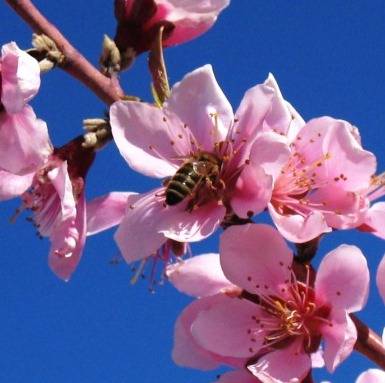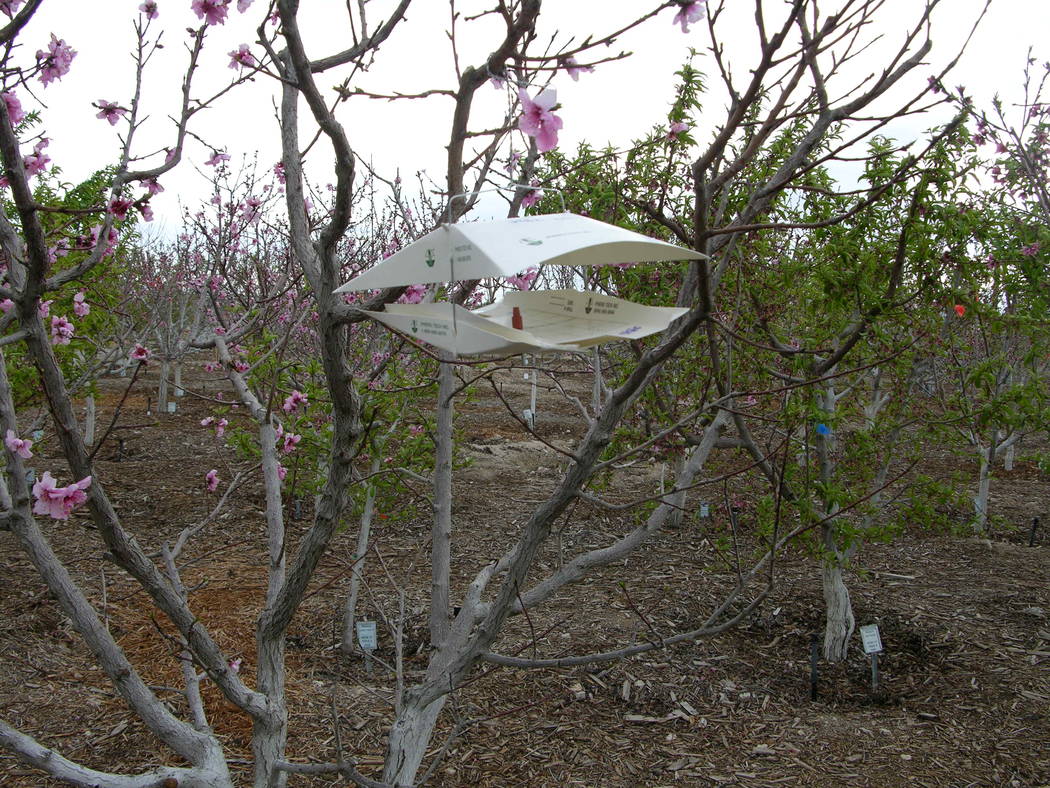Pollenizer tree may not be needed to produce fruit
Q: How close do I need to plant a pollinator tree? I want to plant more fruit trees and was curious how close it needs to be? My neighbors have various fruit trees, and I am about a half mile from Gilcrease Orchard. Is this close enough to be effective, or should I plant my own?
A: I know this sounds like a cop-out, but it should be as close as possible. By the way, a pollinator is an insect that takes pollen from one tree to another. A pollenizer is a tree that provides pollen.
Make sure your trees need a pollenizer tree. Years ago many of our fruit trees required pollenizer trees to set fruit. Advances in breeding and selection have provided newer trees that are self-fruitful, or, in other words, they don’t need another tree to produce an adequate amount of fruit. Many backyard fruit trees do not need pollenizers in our climate.
There are still some varieties of peaches, apricots, almonds and apples that do. It is common to require pollenizer trees for plums and pluots. It should tell you on the label when you buy it.
Setting fruit is not an on and off switch. With some fruit trees, a light fruit set can occur without a pollenizer tree close by. If your trees do require a second tree to set enough fruit, then the farther away a pollenizer tree is, the less likely it will do its job.
Line of sight is important. If pollinators like honeybees can visit the flower in a straight shot, it is better for them than turning a corner. But a half mile is too far away to do any good at all.
As a rule of thumb, honeybees forage up to about 2 miles from the hive, but as distance increases, the likelihood a bee will visit your trees decreases. Also, honeybees spend a lot of time bringing water back to the hive to help cool it on warm days. This takes away from pollination time.
If you know where there is a pollenizer tree, take a bouquet of branches and put them in a vase of water at the base of the tree as flowers are about to open.
Plant a pollenizer tree in the same hole as yours, 18 inches apart, for the sole sake of providing a few flowers for pollination. It doesn’t need to be big to produce enough flowers for pollination.
Q: Can I grow green beans in Las Vegas? If so, can you suggest good varieties and the best time to plant?
A: Beans of all kinds do quite well here if planted at the right time. Green beans are grown as french (filet) beans and snap beans. But beans for shelling and dry beans will grow here as well.
Green beans are a bit fussy as to the time of year for planting, because some varieties don’t like cold soils and they don’t like extremely hot weather. They do not grow well during the coldest parts of fall, winter and spring and during hot weather.
Plant them in fall and spring. Plant seeds in successive waves, two weeks apart from late February until April. Or do that in reverse, August through September, and harvest until the plants stop producing.
The best-tasting green snap beans are some of the old varieties like Blue Lake, Kentucky Wonder, Contender and Topcrop, to name a few, and can tolerate colder soils. Pole beans are more productive than bush beans, but they need to be supported.
Plant beans in full sun. Beans will not germinate in soils colder than 60 degrees F. Some varieties like Dragon Tongue develop crown rot in cold soils and die.
Put bean seeds in warm water for several hours or until they plump up before planting. This speeds up how fast they sprout from the soil. Plant bush beans 1 inch deep and 3 to 4 inches apart.
Plant them on either side of grip tape or drip tubing. Plants in blocks can be 6 inches apart if the soil is wet, while rows are best at 12 inches apart. Follow directions on the seed packet.
Pole beans require the support of poles, teepees, cages or trellises. Set up supports when you sow seed. Air circulation is crucial to warding off disease in pole beans.
Beans require even, consistent watering. Don’t water with a sprinkler or a hose. Once every couple of weeks during hot weather, wash dust off of the leaves to help reduce spider mite problems.
Pick beans at the right time. Pick French beans when they are pencil thick; pick snap beans when you feel seeds forming in pods (the bean should snap when bent in the middle); pick green shell beans when the pods are full size but have not begun to dry; pick dried beans when the pods are stiff and break with pressure.
Q: I sprayed all of my fruit trees with dormant spray this past winter and again a month ago. I sprayed trees done with flowering with Neem oil. Today I discovered leaf-footed plant bugs happily mating on my two almond trees. The almonds are quite small now, but will these bugs feed on them? I lost practically all the almonds to them last year.
A: Following a spray regimen does not guarantee anything. The only sprays I recommend when you can’t see any pests are winter applications of dormant oils. After these applications, it is best not to spray anything unless you see a problem developing.
Leaf-footed plant bugs, the adults, have wings. They fly from unsprayed trees to trees that were recently sprayed.
Now that you see them and you know you have them, it is important to get them under control very quickly before their population explodes. They will soon have babies all over the place that will grow up and become adults that will have babies, and you will have a repeat of last year.
Now that flowering is through, use a spray that contains pyrethrin, resmethrin or permethrin. However, the insecticide that works best is a bad hombre called Sevin. Sevin also works well against squash bugs, which are in the same family.
Both of these insecticides are hard on bees, so use them very early in the morning or at dusk after they go home. Keep an eye on these trees, because adults fly in from neighbor trees during the season.
Q: In an article, you mentioned pheromone traps. Where can they be purchased, and how does one use them? I am hoping that, with this method, I will be able to save a couple of dwarf peach trees.
A: Pheromone traps are commonly used to monitor trees for developing insect activity. Once insects have been caught in these traps and identified, insecticide sprays may be applied to protect the tree or fruit from damage.
Pheromone traps will not substitute for spraying an insecticide when it is needed. For instance, they will do nothing against leaf-footed plant bugs.
Pheromones are hormones released by a wide range of animals, including insects, to communicate to others of the same species. The type of pheromone used for insect control is typically a sex hormone that communicates between the male and female.
A common pheromone used to assist in preventing wormy apples attracts and traps the male coddling moth. The pheromone mimics the female, and the male moth flies into the trap and gets stuck. When significant numbers have been caught, it’s time to spray.
Using pheromone traps pinpoints the right time for spraying, which reduces the total number of sprays needed because the exact timing is known.
However, I have used pheromone traps to eliminate damaging insects of apples, pears, peaches, nectarines and almonds without any pesticide sprays. There are different pheromone traps available for several fruit tree pests, but there are none available for controlling the bores we commonly have in fruit trees in the Las Vegas Valley.
Bob Morris is a horticulture expert living in Las Vegas and professor emeritus for the University of Nevada. Visit his blog at xtremehorticulture.blogspot.com. Send questions to Extremehort@aol.com.


















